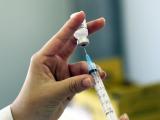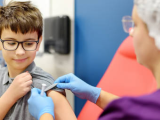Oct 25, 2011 (CIDRAP News) In an effort to protect males against certain cancers and to indirectly protect women, the federal government's vaccine advisory group today approved a recommendation for routine vaccination of boys ages 11 or 12 with the human papillomavirus (HPV) vaccine.
Today's action by the US Centers for Disease Control and Prevention (CDC) Advisory Committee on Immunization Practices (ACIP) strengthens a permissive recommendation that the group made 2 years ago for males ages 9 to 26 to receive the quadrivalent HPV vaccine, following its regulatory approval for use in boys and young men in 2009.
"This is another milestone in the national battle against cancer," said Anne Schuchat, MD, director of the CDC's National Center for Immunization and Respiratory Diseases, at a press conference today.
The CDC estimates that about 20 million Americans are infected with HPV, which is spread by sexual contact, each year. Some types of HPV cause cervical cancer in women, as well as other cancers, such as anal, head, and neck. Other types can cause genital warts.
The recommendation applies only to the quadrivalent HPV vaccine (Gardasil) made by Merck, which is given in three doses. The ACIP said the vaccine can be given to boys as young as 9 and is also recommended in those ages 13 to 21 who haven't already been vaccinated.
She said ACIP strengthened its recommendation based on new information on cancer trends, the vaccine's effectiveness against anal cancer, additional safety information, and cost-benefit analyses. About 40 million doses of the vaccine have been distributed, and it has a good safety record, with mild-to-moderate injection site pain, fever, and headache as the most common side effects, according to Schuchat.
The recommendation will help facilitate a more universal recommendation for 11- and 12-year-old children, which Schuchat said could help simplify messages to physicians and patients' families. The vaccine is recommended for 11- and 12-year-olds not only because they have optimal immune response to the vaccine, but also because the vaccine is most effective when given before people are exposed, she said.
However, Schuchat added that health officials don't expect the robust initial uptake seen for girls when the recommendation was made for them in 2006.
In August the CDC aired concerns about disappointing HPV uptake in teens, after an annual survey found that increases in HPV coverage since 2009 lagged two other vaccines, the tetanus, diphtheria, and acellular pertussis (Tdap) vaccine and the meningococcal conjugate vaccine (MenACWY). The percentage of girls receiving one of three HPV doses grew by only 4 percentage points, to 49%, while the number getting all three doses increased by 5 percentage points, to 32%, the report said. For comparison, Tdap coverage rose by 13 percentage points, to 69%, and MenACWY grew by 9 percentage points, to 63%.
According to figures for 2010, uptake of the vaccine for boys ages 13 to 17 was only 1.5%, she said.
Insurance coverage for the HPV vaccine for boys, which costs about $130, varies by plan; the vaccine is covered by the Vaccine for Children program.
After ACIP delivers its recommendations, CDC staff develops written recommendations, which will be published in an upcoming issue of Morbidity and Mortality Weekly Report.
See also:
Aug 25 CIDRAP News story "Teen vaccine survey finds lagging HPV coverage"

















